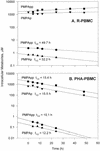Anti-human immunodeficiency virus activity and cellular metabolism of a potential prodrug of the acyclic nucleoside phosphonate 9-R-(2-phosphonomethoxypropyl)adenine (PMPA), Bis(isopropyloxymethylcarbonyl)PMPA
- PMID: 9517941
- PMCID: PMC105507
- DOI: 10.1128/AAC.42.3.612
Anti-human immunodeficiency virus activity and cellular metabolism of a potential prodrug of the acyclic nucleoside phosphonate 9-R-(2-phosphonomethoxypropyl)adenine (PMPA), Bis(isopropyloxymethylcarbonyl)PMPA
Abstract
Bis(isopropyloxymethylcarbonyl) 9-R-(2-phosphonomethoxypropyl)adenine [bis(POC)PMPA] has been identified as a novel prodrug of PMPA. The anti-human immunodeficiency virus activity of bis(POC)PMPA was >100-fold greater than that of PMPA in both an established T-cell line and primary peripheral blood lymphocytes. This improved efficacy was shown to be due to a rapid intracellular uptake of the prodrug resulting in an increased intracellular accumulation of PMPA diphosphate (PMPApp), the pharmacologically active metabolite. PMPApp levels in bis(POC)PMPA-treated cells exceeded by >1,000-fold the levels seen in cells treated with unmodified PMPA in both resting and activated peripheral blood lymphocytes. Significant differences in the intracellular catabolism of PMPA metabolites were noted between the resting and activated lymphocytes. The half-life for the disappearance of PMPApp, derived from either bis(POC)PMPA or PMPA, was 12 to 15 h in the activated lymphocytes and 33 to 50 h in the resting lymphocytes. This long persistence of PMPApp, particularly in resting lymphocytes, may be unique to the nucleoside phosphonate analogs and indicates that effective levels of the active metabolite can be achieved and maintained with relatively infrequent administration of the parent drug.
Figures



References
-
- Abrahamson K, Erikson B O, Holme E, Jodal U, Lindstedt S, Nordin I. Impaired ketogenesis in carnitine depletion caused by short term administration of pivalic acid prodrug. Biochem Med Metab Biol. 1994;52:18–21. - PubMed
-
- Arimilli M N, Kim C U, Dougherty J, Mulato A, Oliyai R, Shaw J P, Cundy K C, Bischofberger N. Synthesis, in vitro evaluation and oral bioavailability of 9-(2-phosphonomethoxypropyl)adenine prodrugs. Antivir Chem Chemother. 1997;8(6):557–567.
-
- Balzarini J, De Clercq E. Acyclic purine nucleoside phosphonates as retrovirus inhibitors. In: Jeffries D J, De Clercq E, editors. Antiviral chemotherapy. New York, N.Y: John Wiley & Sons; 1995. pp. 41–45.
-
- Balzarini J, Holy A, Jindrich J, Naesens L, Snoeck R, Schols D, De Clercq E. Differential antiherpesvirus and antiretrovirus effects of the (S) and (R) enantiomers of acyclic nucleoside phosphonates: potent and selective in vitro and in vivo antiretrovirus activities of (R)-9-(2-phosphonomethoxypropyl)-2,6-diaminopurine. Antimicrob Agents Chemother. 1993;37:332–338. - PMC - PubMed
-
- Balzarini J, Aquaro S, Perno C F, Witvrouw M, Holy A, De Clercq E. Activity of the (R)-enantiomers of 9-(2-phosphonylmethoxypropyl)-adenine and 9-(2-phosphonylmethoxypropyl)-2,6-diaminopurine against human immunodeficiency virus in different human cell systems. Biochem Biophys Res Commun. 1996;219:337–341. - PubMed
Publication types
MeSH terms
Substances
Grants and funding
LinkOut - more resources
Full Text Sources
Other Literature Sources
Medical
Miscellaneous

